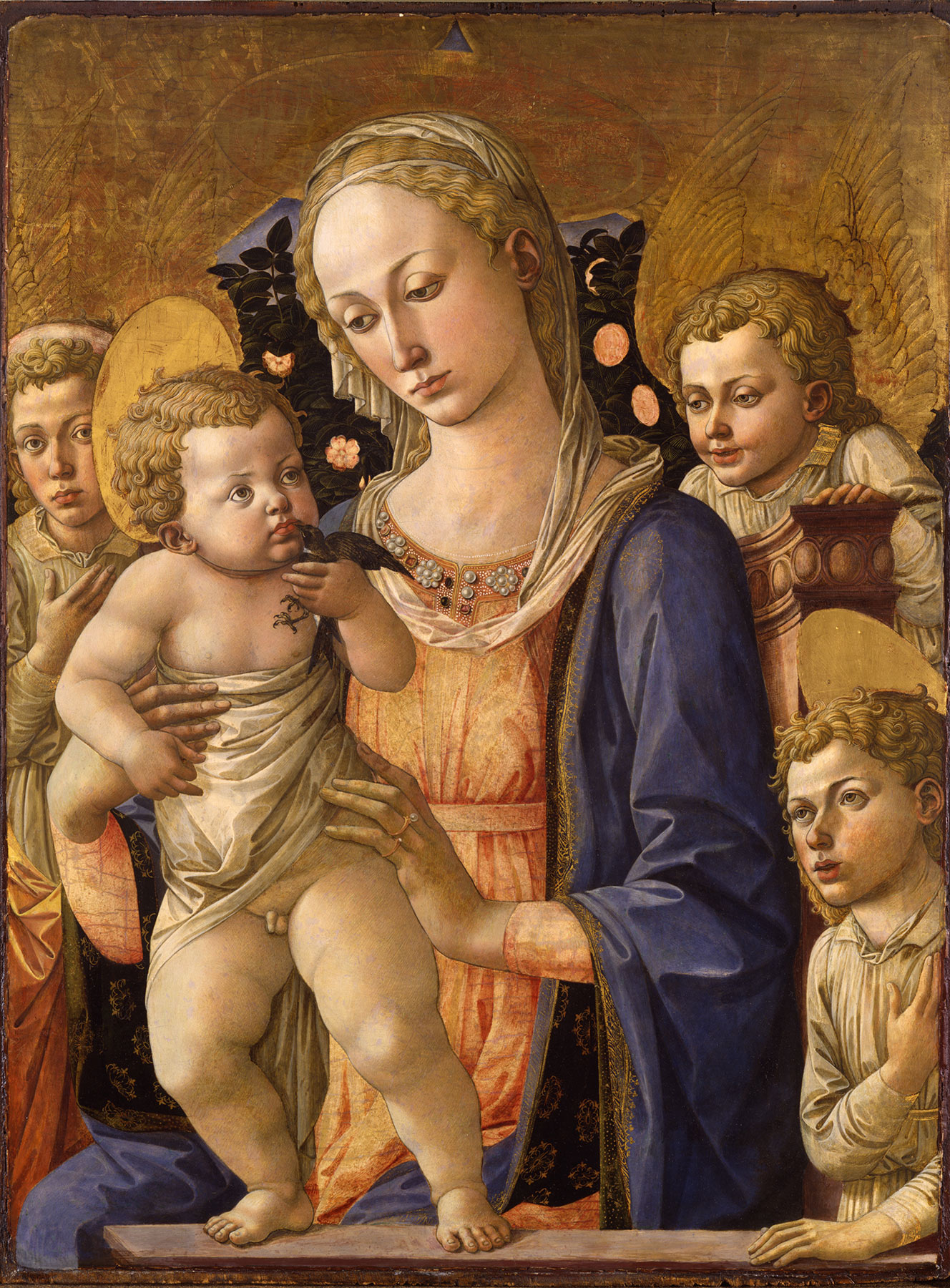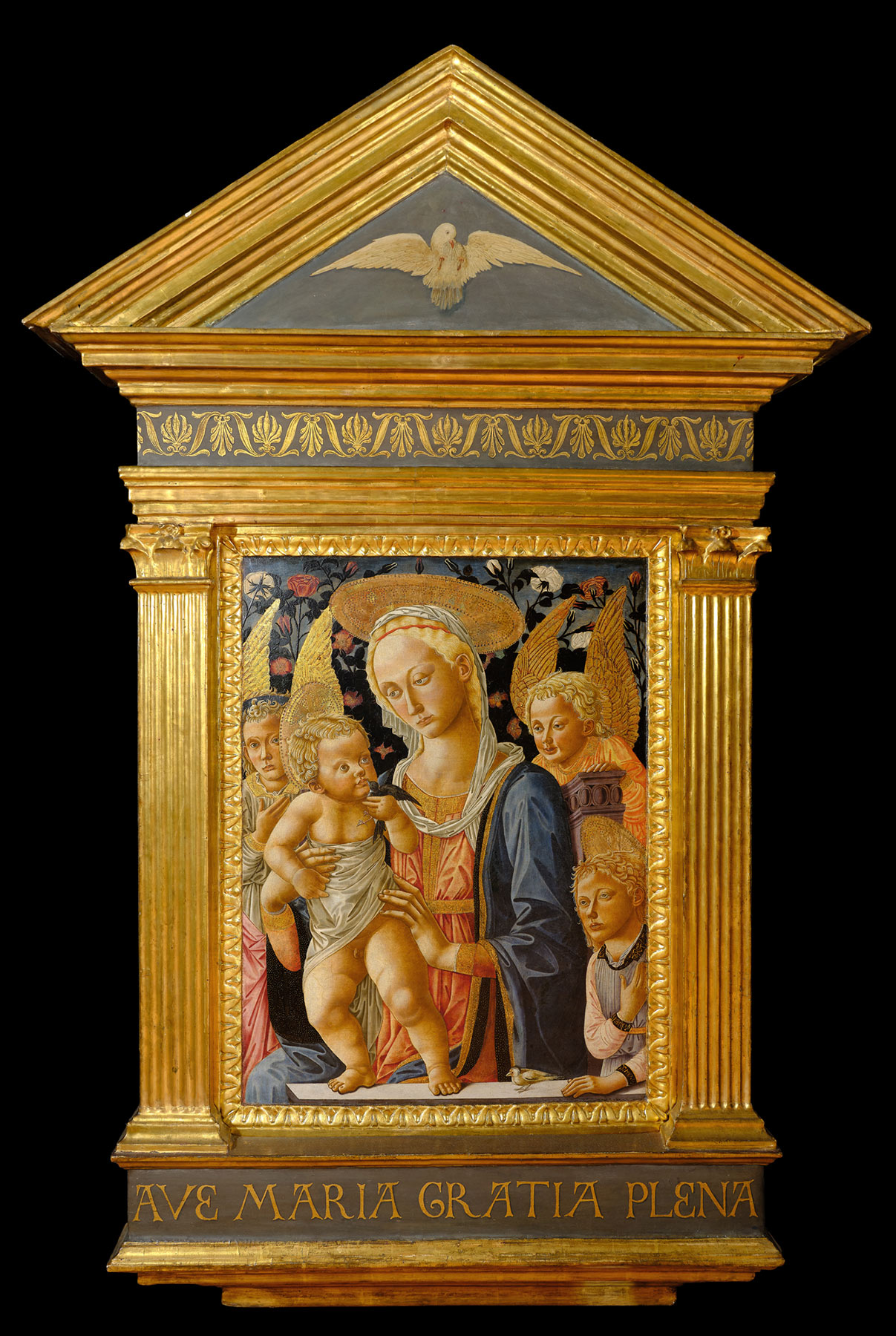Comte de Bourges(?);1 Kleinberger Galleries, Paris; Maitland Fuller Griggs (1872–1943), New York, by 1924
The panel support, measuring 96 by 60.8 centimeters, is 2.2 centimeters thick and has been neither thinned nor cradled. It comprises three vertical planks, approximately 10, 38, and 13 centimeters wide, from left to right, to which the original frame moldings, 2.6 centimeters deep, are applied. The predella moldings attached at the bottom of the support are 6.5 centimeters deep, and beneath them is affixed an antependium carved from a separate piece of wood, measuring approximately 20 by 59 centimeters. Two splits near the lower-right edge of the support are visible through the paint surface, but the principal losses to the paint surface, especially among the figures, are due to solvent damage. Gilding and the painted background are both in an excellent state, while the flesh tones throughout are nearly obliterated and the Virgin’s blue robe is leached of pigment. The other draperies have suffered from numerous small flaking losses and minor scratches. The painting has a dry, “parched” surface from a synthetic varnish applied during an aggressive cleaning in 1957–58.
There has been, and can be, no debate over the inclusion of this and the following three paintings (Virgin and Child with Saint Catherine and Four Angels, Virgin and Child with Three Angels, and Virgin and Child with an Angel) within the large group of works catalogued under the conventional names of Pseudo-Pier Francesco Fiorentino or the Lippi-Pesellino Imitators. Nearly all of the more than two hundred images now associated with those names share a common vocabulary of motifs assembled, cut-and-paste fashion, from a selection of cartoons or patroni either inherited or copied from the workshops of Fra Filippo Lippi and Francesco Pesellino. They also share a distinctive linear approach to drawing and a generally high-key, little-modulated palette that cannot be confused with the output of any other Florentine artist’s studio in the second half of the fifteenth century. Within the group can be found a pronounced variance of quality, however, leading to disagreements over whether one artist or a compagnia of painters should be assigned responsibility for the entire output, and a gradual introduction of motifs derived from other sources, principally works by Filippino Lippi but also by Leonardo da Vinci and Antonello da Messina—confirming that the studio remained productive through and possibly beyond the end of the century.
The first scholar to attempt to isolate the personality of an artist possibly responsible for these paintings was Bernard Berenson, who assembled a nucleus of them in his Florentine Painters of the Renaissance under the name Pier Francesco Fiorentino, an artist known from signed altarpieces found in several provincial centers between San Gimignano and Pisa.2 Over the next two decades, this designation was accepted in scattered publications that added an increasing number of examples to the group, until 1928, when F. Mason Perkins drew attention to a disparity between the monumental paintings signed by Pier Francesco Fiorentino and the numerous domestic tabernacles, chiefly portraying the Virgin and Child with varying numbers of attendant angels or saints, that were being attributed to him.3 Acknowledging the core integrity of Berenson’s research, Perkins adopted a name of convenience—the “Pseudo-Pier Francesco Fiorentino”—for the domestic tabernacles, and this name was “canonized” when it was incorporated by Berenson in the 1932 edition of his lists.4 Federico Zeri, in 1958, suggested applying a more taxonomically descriptive name to the group—“Lippi-Pesellino Imitators”—by way of emphasizing the likelihood that they are not the product of a single personality but probably instead represent the labor of a large commercial enterprise.5 Both names can be found in current scholarship, even within studies that argue for a single artistic vision guiding a populous workshop.
Attempts to establish the historical identity of the artist who might have headed this workshop have focused on two outstanding possibilities. Creighton Gilbert suggested that the artist Riccardo, given the epithet “delle Nostre Donne” (of the Madonnas) in Benedetto Dei’s list of painters active in Florence in 1470, could have been the so-called Pseudo-Pier Francesco Fiorentino, and he associated this name with the documented Riccardo di Benedetto di Niccolò di ser Rucco da Rondinaia (active 1457–87).6 This suggestion has met with very little positive response, as any number of workshops in late quattrocento Florence could be said to deserve an appellation of this sort. A counter proposal that the Pseudo-Pier Francesco Fiorentino might instead be the Piero di Lorenzo di Pratese who is documented as a commercial partner of Francesco Pesellino from 1453 until the latter’s death in 1457 was first raised by Anna Maria Bernacchioni in 1992 and has been argued more fully by Megan Holmes and others.7 This proposal has the merit of rationalizing the artistic sources of much of the imagery employed by the Pseudo-Pier Francesco Fiorentino, but it requires a certain amount of free historical invention, as Piero di Lorenzo died in 1487 and the workshop in question appears to have continued in operation past that date.
The present painting was first attributed to the artist then known as Pier Francesco Fiorentino in 1926, by Gustave Soulier, and this self-evidently correct assessment has been followed by every author to have cited it since then.8 It follows the general practice of the Pseudo-Pier Francesco Fiorentino studio in being based closely on a composition by Francesco Pesellino of the Virgin and Child with three angels, known as the Pratt Madonna, now in the Toledo Museum of Art, Ohio (fig. 1). Holmes inventoried thirty-six examples of paintings by the Pseudo-Pier Francesco Fiorentino that include one or more of the figures taken from this prototype. In the Yale panel, the principal figures of the Virgin and Child are repeated virtually without alteration, faithful even to the patterns of folds in their draperies, except that the Virgin lacks the jeweled collar that she wears in the Toledo painting. Two of the three angels are also reproduced, although with slightly greater variation in their costume and with the angel at the right positioned higher and closer to the Virgin’s shoulder. The foreground angel from the Toledo painting has been suppressed; the rectangular format of the original converted to a narrower, arched-top profile; and the burnished gold ground replaced by a hedge of roses against a blue sky, a device that appears frequently in paintings from the Pseudo-Pier Francesco Fiorentino workshop and a germinal version of which is included in the Pratt Madonna by Pesellino.

Despite its disfiguring abrasions, the present painting must be recognized as one of the highest-quality examples of the entire Pseudo-Pier Francesco Fiorentino group and possibly one of the earliest. Another version of the composition, at the Gallerie degli Uffizi, Florence (fig. 2), which shares the color changes introduced in the Yale painting but retains the third angel and rectangular format of Pesellino’s model, bears a date of 1459 inscribed on its reverse, the only fixed date known on any of the paintings from this workshop. While the outlines of the figures were in both cases transferred by mechanical means, the underdrawing, too easily visible in the present state of the Yale painting, is freer and more confident here than in the Uffizi version or in any but a small handful of other works by this artist, while some passages of modeling (now sadly impaired) recall the accomplishment of works by Pesellino and his studio, like the Virgin and Child with a Swallow shown before a marble niche, in the Isabella Stewart Gardner Museum, Boston, or its replica in the Keresztény Múzeum, Esztergom, Hungary.9 Following the hypothesis that the Pseudo-Pier Francesco Fiorentino might have been Piero di Lorenzo di Pratese and that the latter was responsible for assisting Pesellino in producing paintings like the Gardner and Esztergom Virgins—which, it should be admitted, is a plausible theory, not a certainty—it is at least possible that paintings like the Yale tabernacle might have been further works created by him alone before his partnership with Pesellino was dissolved at the death of the more talented painter in 1457.

The frame of the present painting is original and of a type—with a sloping frieze painted with gold stars on a blue field and sporting anthemion decorations at the spring of the arch on either side and at its apex—frequently encountered on other works by the Pseudo-Pier Francesco Fiorentino as well as on domestic tabernacles from other Florentine artists’ studios in the second half of the fifteenth century. The well-preserved coats of arms in the antependium and at either end of the predella have not been identified. They do not represent any recorded Florentine family or corporation and might be presumed to indicate a provincial, probably Tuscan origin: no evidence has yet emerged suggesting that the Pseudo-Pier Francesco Fiorentino worked exclusively for Tuscan clients, although there is a presumption that this might have been the case. —LK
Published References
Soulier, Gustave. “Pier Francesco Fiorentino pittore di Madonne.” Dedalo 7, no. 1 (1926–27): 86–101., 96; van Marle. Raimond. The Development of the Italian Schools of Painting. Vol. 13. The Hague: M. Nijhoff, 1931., 447; Berenson, Bernard. Italian Pictures of the Renaissance: A List of the Principal Artists and Their Works with an Index of Places. Oxford: Clarendon, 1932., 451; “Pesellino’s Masterpiece.” Toledo Museum of Art, Museum News 110 (December 1945): n.p., n.p.; Berenson, Bernard. Italian Pictures of the Renaissance, A List of the Principal Artists and Their Works with an Index of Places: Florentine School. 2 vols. London: Phaidon, 1963., 1:173; Seymour, Charles, Jr. Early Italian Paintings in the Yale University Art Gallery. New Haven: Yale University Art Gallery, 1970., 169, 317, no. 122; Fredericksen, Burton B., and Federico Zeri. Census of Pre-Nineteenth-Century Italian Paintings in North American Public Collections. Cambridge, Mass.: Harvard University Press, 1972., 600; Holmes, Megan. “Copying Practices and Marketing Strategies in a Fifteenth-Century Florentine Painter’s Workshop.” In Artistic Exchange and Cultural Translation in the Italian Renaissance City, ed. Stephen Campbell and Stephen Milner, 38–74. Cambridge: Cambridge University Press, 2004. , 69n44; Christopher Daly, in De Marchi, Andrea, and Davide Civettini, eds. Pseudo Pier Francesco Fiorentino: Cristo di dolori. Florence: Enrico Frascione antiquario, 2022. , 44
Notes
-
According to a label on the reverse, which may possibly be a fictitious provenance supplied by Kleinberger Galleries. The reverse also bears a stamp of the Austrian Bundesdenkmalamt, dating after 1918. ↩︎
-
Berenson, Bernard. The Florentine Painters of the Renaissance with an Index to Their Works. New York: G. P. Putnam, 1900., 132–34; and Berenson, Bernard. The Florentine Painters of the Renaissance with an Index to Their Works. 3rd. ed. New York: G. P. Putnam’s Sons, 1909., 166–72. ↩︎
-
Perkins, F. Mason. “Nuovi appunti sulla Galleria Belle Arti di Siena.” La Balzana 2 (1928): 183–203. , 188–89. ↩︎
-
Berenson, Bernard. Italian Pictures of the Renaissance: A List of the Principal Artists and Their Works with an Index of Places. Oxford: Clarendon, 1932., 449–52. ↩︎
-
Zeri, Federico. “Sul problema di Niccolò Tegliacci e Luca di Tommè.” Paragone 5, no. 105 (September 1958): 3–16., 16–21. ↩︎
-
Gilbert, Creighton. L’arte del quattrocento: Nelle testimonianze coeve. Florence: IRSA, 1988., 202. ↩︎
-
Anna Maria Bernacchioni, in Gregori, Mina, Antonio Paolucci, and Cristina Acidini Luchinat, eds. Maestri e botteghe: Pittura a Firenze alla fine del quattrocento. Exh. cat. Cinisello Balsano, Milan: Silvana, 1992., 160–61; and Holmes, Megan. “Copying Practices and Marketing Strategies in a Fifteenth-Century Florentine Painter’s Workshop.” In Artistic Exchange and Cultural Translation in the Italian Renaissance City, ed. Stephen Campbell and Stephen Milner, 38–74. Cambridge: Cambridge University Press, 2004. , with previous bibliography. See also Zanobi di Migliore(?), Virgin and Child Enthroned with Two Angels. ↩︎
-
Soulier, Gustave. “Pier Francesco Fiorentino pittore di Madonne.” Dedalo 7, no. 1 (1926–27): 86–101., 96. ↩︎
-
Respectively, inv. no. P16w11, https://www.gardnermuseum.org/experience/collection/11745; and inv. no. 55.187, https://www.keresztenymuzeum.hu/collections.php?mode=work&wid=67&page=0&vt=. ↩︎